Browse Primary Sources
Locate primary sources, including images, objects, media, and texts. Annotations by scholars contextualize sources.
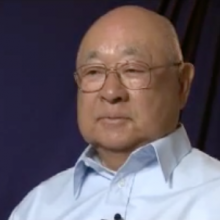
Japanese American Incarceration at Amache, Colorado, Interview
Norman I. Hirose is a Nisei (second generation) Japanese American born in 1926 in Oakland, California. He grew up in Oakland and Berkeley, California. After the bombing of Pearl Harbor, the Hirose family was removed to the Tanforan Assembly Center, California (a converted racetrack), and later to Topaz incarceration camp, Utah.
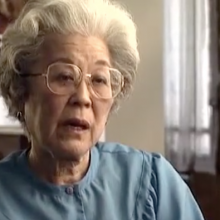
Japanese American Incarceration at Manzanar, California, Interview
Aiko Herzig-Yoshinaga is a Nisei (second generation) Japanese American born in 1925 in Los Angeles. She was incarcerated at Manzanar, California, and later Jerome and Rohwer, Arkansas.

Japanese American Incarceration at Heart Mountain Interview
Mits Koshiyama is a Nisei (second generation) Japanese American born in 1924 in Mountain View, California. He grew up in the Santa Clara Valley, working on his family's leased strawberry farm. In June 1942, he was removed to Santa Anita Assembly Center, California (a converted race track), and then taken to Heart Mountain incarceration camp, Wyoming.

Japanese American Incarceration, Interview
Kenge Kobayashi is a Nisei (second generation) Japanese American born in 1926 in Imperial Valley, California. With his family, he was incarcerated at Tulare Assembly Center, California, and then at the Gila River, Arizona, and Tule Lake, California, incarceration camps. A traumatic episode in the years of incarceration was the imposition of a loyalty questionnaire in early 1943.
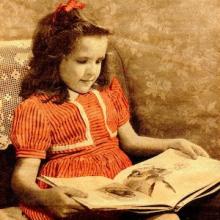
My Weekly Reader
First launched in 1928, My Weekly Reader sought to make the national news accessible to elementary school children. By the early 1970s grade-specific versions were available for students from preschool to the sixth grade.
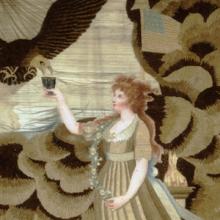
Liberty in the Form of the Goddess of Youth
Mary Green of Worcester, MA, created this embroidery in 1804 at the age of 16. She based it on the 1796 engraving, "Liberty in the Form of the Goddess of Youth Giving Support to the Bald Eagle," by artist-entrepreneur, Edward Savage (fig. 2).
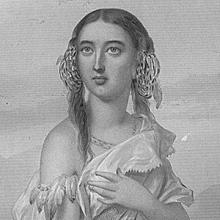
Pocahontas (Matoaka) 1595-1617
Pocahontas, a legendary figure in American history, was the daughter of a powerful 17th-century Powhatan chief. Allegedly seeking retribution for the murder of two tribesmen by the English, Powhatans captured John Smith, one of the founders of Jamestown, Virginia, an English settlement established in 1607.
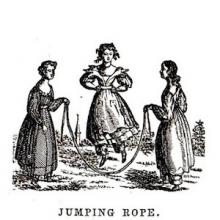
Jumping Rope
Lydia Maria Child included this selection on how to jump rope in The Girls Own Book, a book published in 1833. Why did girls in early 19th-century America need instructions on how to jump rope? Why did Child's feel the need to caution girls?
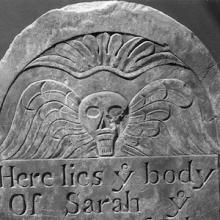
Gravestones and Childhood
In 17th-century New England, Puritan beliefs about "infant depravity" (born with "original sin") generated anxieties about "eternal damnation" that shaped methods of childrearing and notions of death. Puritan beliefs can be "read" on the gravestones often made out of dark grey slate.
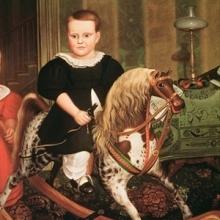
Hobby Horse
This oil on canvas painting by an unknown American folk artist was painted around 1840. It depicts two siblings at play. While their mother is absent from the picture, she presided over the "private sphere" of the home as prescribed by the ideology of "separate spheres" that defined everyday life in 19th-century America.
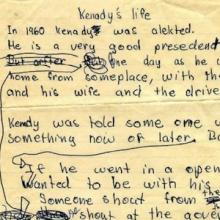
JFK's Assassination
The assassination of John F. Kennedy on November 22nd in 1963 shocked, saddened, and bewildered American children. Girls and boys of all ages watched the funeral broadcast on television—including those who lived abroad during the 1960s. For many children, seeing their distraught parents and other adults in mourning undermined their sense of security.
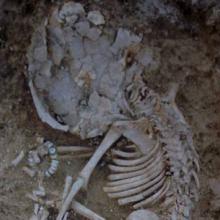
Neolithic Baby Burial
This infant burial is from Çatalhöyük , a Neolithic settlement in Turkey that was occupied continuously for 2,500 years, between 8000 and 6400 BCE. The infant was between six months and one year old, and the burial demonstrates great care. The infant was placed in a fetal position facing south and rested on a reed mat or basket. Red ochre, a mineral powder, had been used to decorate the body.
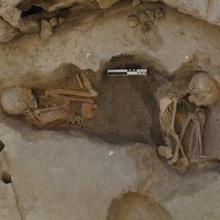
Sibling Burial
The two children whose skeletons are shown in this photograph were both under 10 years of age, and were probably buried at the same time. An earlier burial of a baby was found at a slightly lower level in the space between them.
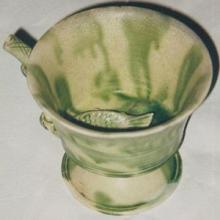
Sippy Cup
This ceramic cup with a drinking spout is from the cargo of an Arab or Indian ship that sank in the Strait of Malacca between 826 and 850 CE. The ship, which contained thousands of other ceramic pieces, was probably bound for the Persian Gulf. The cup was made at the Changshan ceramic production center, whose kilns produced export wares during the Tang dynasty (618-906 CE).
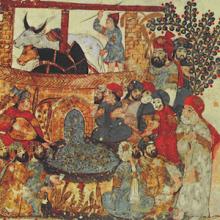
Maqamat al-Hariri, Garden Scene by al-Wasiti
The image by 13th–century illustrator al-Wasiti (fl. 1237) is from the Maqamat (Assemblies), a collection of stories of a picaresque hero. In the upper half of the illustration, a boy in a short tunic and cap with tiraz embroidered bands, leads animals yoked to the saqiyya, a geared water-raising device that irrigated fields and gardens.
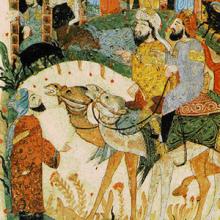
Maqamat al-Hariri, Rural Scenes by al-Wasiti
The image by 13th–century illustrator al-Wasiti is from the Maqamat (Assemblies), a collection of stories of a picaresque hero. The author, al-Hariri (1054-1122 CE), is an important figure in Arabic literary history. The illustrations belong to the Baghdad School of miniature illustration, and depict scenes of ordinary life. The scene illustrates aspects of a village life.
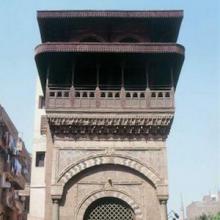
Kuttab, or Primary Level Qur’an School
This public building of Mamluk Cairo in Egypt has two functions. Its lower level housed a sabil, or fountain, for dispensing water to thirsty travelers and denizens of the city, and its upper level was a public primary school for the teaching of Qur'an, called a kuttab.
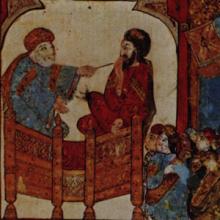
Maqamat al-Hariri, Kuttab School
In this painting of a kuttab, or primary school, boys sit on a mat or carpet huddled close together with their writing boards. Boys, and sometimes girls, learned to recite the Qur'an at an early age, as well as the basics of reading, writing, and arithmetic in schools called kuttabs. It might be held in a mosque, a building especially for the purpose, or an open courtyard, as in West Africa.
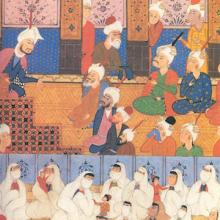
Majalis al-‘ushshak: Gathering in a Mosque
This image from a 16th-century Persian manuscript illustrates the visit of a renowned teacher to a mosque. Such visits were much anticipated, and this image demonstrates the wide range of people who attended. Seating arrangements illustrate the social organization for the event. The guest of honor sat on the seat at the top of the minbar, or pulpit, while the older men sat in the first row.
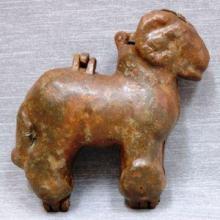
Animal Baking Mold
This hollow cast iron container is a baking mold used for shaping bread or cake for children, according to archaeologists. It was excavated with a similar elephant mold. The mold is from the excavation of Hallado en al-Fudyan in Jordan, dated to the 8th century CE, during the Umayyad Islamic period. The mold is 17 cm high, 16.5 cm wide, and 6 cm deep (6.7 x 6.5 x 2.4 inches).